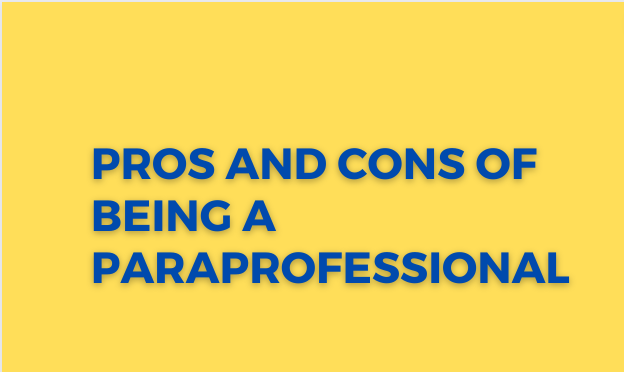Paraprofessionals play a crucial role in various fields, providing support and assistance to professionals in their respective areas. In the following list, we will explore pros and cons of paraprofessionals, discussing the advantages they bring in terms of collaboration, specialized support, and cost-effectiveness, as well as the potential challenges and considerations associated with their roles.
Pros:
- Support to Professionals: Paraprofessionals assist professionals, such as teachers or healthcare providers, in their daily tasks, allowing them to focus on their core responsibilities.
- Increased Productivity: With the help of paraprofessionals, professionals can accomplish more tasks efficiently, enhancing overall productivity.
- Specialized Expertise: Paraprofessionals often possess specialized skills and knowledge in specific areas, providing targeted support in their respective fields.
- Cost-Effective: Hiring paraprofessionals can be a cost-effective solution compared to hiring professionals with higher salaries.
- Collaboration and Teamwork: Paraprofessionals work closely with professionals, fostering collaboration and teamwork.
- Individualized Support: They can provide one-on-one support to individuals with special needs or learning differences, addressing their unique requirements.
- Flexible Roles: Paraprofessionals can adapt to various roles and responsibilities based on the specific needs of the profession or organization.
- Reduced Workload: By taking on certain tasks, paraprofessionals alleviate the workload of professionals, reducing stress and burnout.
- Close Interaction with Clients or Students: Paraprofessionals often have direct interaction with clients, students, or patients, providing personalized care and assistance.
- Knowledge Transfer: Paraprofessionals can share their expertise and experiences with professionals, contributing to professional development.
- Support for Inclusion: They contribute to inclusive environments by providing additional support to individuals with disabilities or diverse backgrounds.
- Bridge the Gap: Paraprofessionals bridge the gap between professionals and clients/students, ensuring smooth communication and understanding.
- Adaptability: Paraprofessionals are adaptable and can work in different settings, such as schools, healthcare facilities, or social service agencies.
- Emotional Support: They offer emotional support and guidance to clients or students, fostering a positive and nurturing environment.
- Assistance with Routine Tasks: Paraprofessionals can assist with routine tasks, such as administrative duties or personal care, freeing professionals to focus on critical aspects of their roles.
- Increased Access to Services: Paraprofessionals expand the reach of services, ensuring more individuals can receive support and assistance.
- Continuity of Care: They provide continuity of care or support, ensuring consistency in services even during the absence of professionals.
- Improved Student Performance: Paraprofessionals can positively impact student performance by providing individualized attention and support in educational settings.
- Language Support: Paraprofessionals with multilingual skills can offer language support to individuals with limited English proficiency.
- Positive Role Models: Paraprofessionals can serve as positive role models for clients or students, inspiring and motivating them.
Cons:
- Limited Decision-Making Authority: Paraprofessionals may have limited decision-making authority, requiring constant supervision from professionals.
- Training and Qualifications: Not all paraprofessionals receive the same level of training or possess the same qualifications, potentially affecting the quality of support provided.
- Potential Role Confusion: There may be instances of role confusion or overlapping responsibilities between professionals and paraprofessionals.
- Dependency on Professionals: Paraprofessionals may heavily rely on professionals for guidance and direction, limiting their autonomy.
- Supervision Requirements: Professionals need to dedicate time and effort to supervise and guide paraprofessionals effectively.
- Limited Career Advancement: Paraprofessionals may have limited opportunities for career advancement compared to professionals in their respective fields.
- Salary Disparity: Paraprofessionals often earn lower salaries compared to professionals, potentially leading to job dissatisfaction.
- Emotional Toll: Paraprofessionals may experience emotional stress or burnout due to the nature of their work, especially when dealing with challenging situations or clients.
- Need for Clear Communication: Effective communication between professionals and paraprofessionals is crucial to ensure understanding and avoid misunderstandings.
- Risk of Burnout: Paraprofessionals may experience high levels of stress and burnout due to the demanding nature of their roles.
- Professional Boundaries: Maintaining professional boundaries can be challenging for paraprofessionals, especially when working closely with clients or students.
- Limited Autonomy: Paraprofessionals may have limited decision-making authority or autonomy in their roles.
- Variable Workload: The workload of paraprofessionals may fluctuate based on the needs of the profession or organization.
- Professional Development Opportunities: Limited access to professional development opportunities can hinder the growth and advancement of paraprofessionals.
- Lack of Recognition: Paraprofessionals may not receive the same level of recognition or appreciation as professionals in their respective fields.
- Balancing Multiple Roles: Paraprofessionals may be required to balance multiple roles or responsibilities simultaneously, which can be challenging.
- Professional Collaboration: Collaborating effectively with professionals from different disciplines may require effort and coordination from paraprofessionals.
- Workplace Hierarchies: Paraprofessionals may encounter workplace hierarchies or power dynamics that affect their interactions with professionals.
- Job Insecurity: Paraprofessionals may experience job insecurity due to the contractual nature of their positions or budget constraints.
- Client or Student Dependency: Clients or students may develop strong dependencies on paraprofessionals, making transitions or changes in support challenging.
Pros
- Support to Professionals
- Increased Productivity
- Specialized Expertise
- Cost-Effective
- Collaboration and Teamwork
- Individualized Support
- Flexible Roles
- Reduced Workload
- Close Interaction with Clients or Students
- Knowledge Transfer
- Support for Inclusion
- Bridge the Gap
- Adaptability
- Emotional Support
- Assistance with Routine Tasks
- Increased Access to Services
- Continuity of Care
- Improved Student Performance
- Language Support
- Positive Role Models
Cons
- Limited Decision-Making Authority
- Training and Qualifications
- Potential Role Confusion
- Dependency on Professionals
- Supervision Requirements
- Limited Career Advancement
- Salary Disparity
- Emotional Toll
- Need for Clear Communication
- Risk of Burnout
- Professional Boundaries
- Limited Autonomy
- Variable Workload
- Professional Development Opportunities
- Lack of Recognition
- Balancing Multiple Roles
- Professional Collaboration
- Workplace Hierarchies
- Job Insecurity
- Client or Student Dependency


